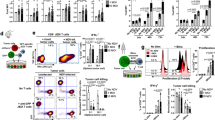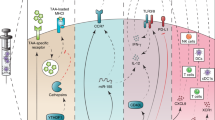Abstract
Although dendritic cell (DC)-based immunotherapy is considered a promising approach for cancer treatment, a large quantity of DC vaccine is required for effective sensitization/activation of immune cells because of the poor migratory ability of administered DCs into regional lymphoid tissue. In this study, we created a DC vaccine sufficiently transduced with CC chemokine receptor-7 gene (CCR7/DCs) by applying RGD fiber-mutant adenovirus vector (AdRGD), and investigated its immunological characteristics and therapeutic efficacy. CCR7/DCs acquired strong chemotactic activity for CC chemokine ligand-21 (CCL21) and exhibited an immunophenotype similar to mature DCs but not immature DCs with regard to major histocompatibility complex/costimulatory molecule-expression levels and allogenic T cell proliferation-stimulating ability, while maintaining inherent endocytotic activity. Importantly, CCR7/DCs injected intradermally into mice could accumulate in draining lymph nodes about 5.5-fold more efficiently than control AdRGD-applied DCs. Reflecting these properties of CCR7/DCs, DC vaccine genetically engineered to simultaneously express endogenous antigen and CCR7 could elicit more effective antigen-specific immune response in vivo using a lower dosage than DC vaccine transduced with antigen alone. Therefore, the application of CCR7/DCs having positive migratory ability to lymphoid tissues may contribute to reduction of efforts and costs associated with DC vaccine preparation by considerably reducing the DC vaccine dosage needed to achieve effective treatment by DC-based immunotherapy.
This is a preview of subscription content, access via your institution
Access options
Subscribe to this journal
Receive 12 print issues and online access
$259.00 per year
only $21.58 per issue
Buy this article
- Purchase on Springer Link
- Instant access to full article PDF
Prices may be subject to local taxes which are calculated during checkout







Similar content being viewed by others
References
Nestle FO et al. Vaccination of melanoma patients with peptide- or tumor lysate-pulsed dendritic cells. Nat Med 1998; 4: 328–332.
Thurner B et al. Vaccination with Mage-3A1 peptide-pulsed mature, monocyte-derived dendritic cells expands specific cytotoxic T cells and induces regression of some metastases in advanced stage IV melanoma. J Exp Med 1999; 190: 1669–1678.
Lodge PA et al. Dendritic cell-based immunotherapy of prostate cancer: immune monitoring of a phase II clinical trial. Cancer Res 2000; 60: 829–833.
Yu JS et al. Vaccination of malignant glioma patients with peptide-pulsed dendritic cells elicits systemic cytotoxicity and intracranial T-cell infiltration. Cancer Res 2001; 61: 842–847.
Banchereau J, Steinman RM . Dendritic cells and the control of immunity. Nature 1998; 392: 245–252.
Steinman RM et al. Antigen capture, processing, and presentation by dendritic cells: recent cell biological studies. Hum Immunol 1999; 60: 562–567.
Mellman I, Steinman RM . Dendritic cells: specialized and regulated antigen processing machines. Cell 2001; 106: 255–258.
Gunn MD et al. Mice lacking expression of secondary lymphoid organ chemokine have defects in lymphocyte homing and dendritic cell localization. J Exp Med 1999; 189: 451–460.
Förster R et al. CCR7 coordinates the primary immune response by establishing functional microenvironments in secondary lymphoid organs. Cell 1999; 99: 23–33.
Arthur JF et al. A comparison of gene transfer methods in human dendritic cells. Cancer Gene Ther 1997; 4: 17–25.
Okada N et al. Efficient gene delivery into dendritic cells by fiber-mutant adenovirus vectors. Biochem Biophys Res Commun 2001; 282: 173–179.
Okada N et al. Efficient antigen gene transduction using Arg–Gly–Asp fiber-mutant adenovirus vectors can potentiate antitumor vaccine efficacy and maturation of murine dendritic cells. Cancer Res 2001; 61: 7913–7919.
Okada N et al. Gene transduction efficiency and maturation status in mouse bone marrow-derived dendritic cells infected with conventional or RGD fiber-mutant adenovirus vectors. Cancer Gene Ther 2003; 10: 421–431.
Okada N et al. Dendritic cells transduced with gp100 gene by RGD fiber-mutant adenovirus vectors are highly efficacious in generating anti-B16BL6 melanoma immunity in mice. Gene Therapy 2003; 10: 1891–1902.
Lanzavecchia A . Identifying strategies for immune intervention. Science 1993; 260: 937–944.
Lappin MB et al. Analysis of mouse dendritic cell migration in vivo upon subcutaneous and intravenous injection. Immunology 1999; 98: 181–188.
Martín-Fontecha A et al. Regulation of dendritic cell migration to the draining lymph node: impact on T lymphocyte traffic and priming. J Exp Med 2003; 198: 615–621.
Kleindienst P, Brocker T . Endogenous dendritic cells are required for amplification of T cell responses induced by dendritic cell vaccines in vivo. J Immunol 2003; 170: 2817–2823.
Granucci F et al. Early events in dendritic cell maturation induced by LPS. Microbes Infect 1999; 1: 1079–1084.
Dhodapkar MV et al. Antigen-specific inhibition of effector T cell function in human after injection of immature dendritic cells. J Exp Med 2001; 193: 233–238.
Steinman RM, Nussenzweig MC . Avoiding horror autotoxicus: the importance of dendritic cells in peripheral T cell tolerance. Proc Natl Acad Sci USA 2002; 99: 351–358.
Steinbrink K et al. CD4+ and CD8+ anergic T cells induced by interleukin-10-treated human dendritic cells display antigen-specific suppressor activity. Blood 2002; 99: 2468–2476.
Mahnke K et al. Immature, but not inactive: the tolerogenic function of immature dendritic cells. Immunol Cell Biol 2002; 80: 477–483.
Huang FP et al. A discrete subpopulation of dendritic cells transports apoptotic intestinal epithelial cells to T cell areas of mesenteric lymph nodes. J Exp Med 2000; 191: 435–444.
Hemmi H et al. Skin antigens in the steady state are trafficked to regional lymph nodes by transforming growth factor-β1-dependent cells. Int Immunol 2001; 13: 695–704.
Yanagawa Y, Onoe K . CCR7 ligands induce rapid endocytosis in mature dendritic cells with concomitant up-regulation of Cdc42 and Rac activities. Blood 2003; 101: 4923–4929.
Saeki H, Moore AM, Brown MJ, Hwang ST . Secondary lymphoid-tissue chemokine (SLC) and CC chemokine receptor 7 (CCR7) participate in the emigration pathway of mature dendritic cells from the skin to regional lymph nodes. J Immunol 1999; 162: 2472–2475.
Curiel-Lewandrowski C et al. Transfection of immature murine bone marrow-derived dendritic cells with the granulocyte-macropharge colony-stimulating factor gene potently enhances their in vivo antigen-presenting capacity. J Immunol 1999; 163: 174–183.
Hirao M et al. CC chemokine receptor-7 on dendritic cell is induced after interaction with apoptotic tumor cells: critical role in migration from the tumor site to draining lymph nodes. Cancer Res 2000; 60: 2209–2217.
Wu MT, Hwang ST . CXCR5-transduced bone marrow-derived dendritic cells traffic to B cell zones of lymph nodes and modify antigen-specific immune responses. J Immunol 2002; 168: 5096–5102.
Nakamura M et al. Dendritic cells genetically engineered to simultaneously express endogenous tumor antigen and granulocyte macrophage colony-stimulating factor elicit potent therapeutic antitumor immunity. Clin Cancer Res 2002; 8: 2742–2749.
de Vries IJM et al. Effective migration of antigen-pulsed dendritic cells to lymph nodes in melanoma patients is determined by their maturation state. Cancer Res 2003; 63: 12–17.
Eggert AAO et al. Analysis of dendritic cell trafficking using EGFP-transgenic mice. Immunol Lett 2003; 89: 17–24.
Scandella E et al. Prostaglandin E2 is a key factor for CCR7 surface expression and migration of monocyte-derived dendritic cells. Blood 2002; 100: 1354–1361.
Scandella E et al. CCL19/CCL21-triggered signal transduction and migration of dendritic cells requires prostaglandin E2. Blood 2004; 103: 1595–1601.
Sato M et al. Generation of mature dendritic cells fully capable of T helper type 1 polarization using OK-432 combined with prostaglandin E2 . Cancer Sci 2003; 94: 1091–1098.
Nair S et al. Injection of immature dendritic cells into adjuvant-treated skin obviates the need for ex vivo maturation. J Immunol 2003; 171: 6275–6282.
Pfeifer JD et al. Phagocytic processing of bacterial antigens for class I MHC presentation to T cells. Nature 1993; 361: 359–362.
Okabe M et al. Green mice as a source of ubiquitous green cells. FEBS Lett 1997; 407: 313–319.
Mizuguchi H et al. A simplified system for constructing recombinant adenoviral vectors containing heterologous peptides in the HI loop of their fiber knob. Gene Therapy 2001; 8: 730–735.
Mizuguchi H, Kay MA . Efficient construction of a recombinant adenovirus vector by an improved in vitro ligation method. Hum Gene Ther 1998; 9: 2577–2583.
Mizuguchi H, Kay MA . A simple method for constructing E1- and E1/E4-deleted recombinant adenoviral vectors. Hum Gene Ther 1999; 10: 2013–2017.
Lutz MB et al. An advanced culture method for generating large quantities of highly pure dendritic cells from mouse bone marrow. J Immunol Methods 1999; 223: 77–92.
Okada N et al. Administration route-dependent vaccine efficiency of murine dendritic cells pulsed with antigens. Br J Cancer 2001; 84: 1564–1570.
Acknowledgements
We are grateful to KIRIN Brewery Co., Ltd (Tokyo, Japan) for providing recombinant murine GM-CSF, to Dr Clifford V Harding (Department of Pathology, Case Western Reserve University, Cleveland, OH, USA) for providing the CD8-OVA 1.3 cells, and to Dr Masaru Okabe (Genome Information Research Center, Osaka University, Suita, Japan) for providing the C57BL/6 TgN(act-EGFP)OsbC14-Y01-FM131 mice. This study was supported in part by the Research on Health Sciences Focusing on Drug Innovation from the Japan Health Sciences Foundation; by a Grant-in-Aid for Young Scientists (16790114) from the Ministry of Education, Culture, Sports, Science and Technology of Japan; by Senri Life Science Foundation; by the Science Research Promotion Fund of the Japan Private School Promotion Foundation; by grants from the Bioventure Development Program of the Ministry of Education, Culture, Sports, Science and Technology of Japan; and by grants from the Ministry of Health, Labour and Welfare in Japan.
Author information
Authors and Affiliations
Rights and permissions
About this article
Cite this article
Okada, N., Mori, N., Koretomo, R. et al. Augmentation of the migratory ability of DC-based vaccine into regional lymph nodes by efficient CCR7 gene transduction. Gene Ther 12, 129–139 (2005). https://doi.org/10.1038/sj.gt.3302358
Received:
Accepted:
Published:
Issue Date:
DOI: https://doi.org/10.1038/sj.gt.3302358
Keywords
This article is cited by
-
Exploiting innate immunity for cancer immunotherapy
Molecular Cancer (2023)
-
Engineering dendritic cell vaccines to improve cancer immunotherapy
Nature Communications (2019)
-
An autologous dendritic cell vaccine polarizes a Th-1 response which is tumoricidal to patient-derived breast cancer cells
Cancer Immunology, Immunotherapy (2019)
-
Tracking dendritic cell migration into lymph nodes by using a novel PET probe 18F-tetrafluoroborate for sodium/iodide symporter
EJNMMI Research (2017)
-
Co-transfection Gene Delivery of Dendritic Cells Induced Effective Lymph Node Targeting and Anti-tumor Vaccination
Pharmaceutical Research (2013)



